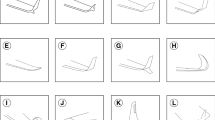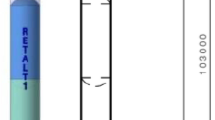Abstract
In order to design a hypersonic vehicle for a wide-ranged Mach number, a novel parallel vehicle for a wide-speed range has been proposed. In this paper, we employ a numerical method to investigate a parallel vehicle’s aerodynamic performance and flow field characteristics. The obtained results show that the aerodynamic performance of the novel parallel vehicle is better than that of the waverider designed with a single Mach number for the wide-speed range. With the increase in Mach number, the lift-to-drag ratio of the novel parallel vehicle first increases and then decreases. When the Mach number is 7 and the angle of attack is 3°, the lift-to-drag ratio is the largest, and its value is 3.968. When the angle of attack is 3°, the lift-to-drag ratio is not lower than 3.786 in the range considered in the current study, and the novel parallel vehicle’s aerodynamic performance is good. The wing changes the drag performance of the parallel vehicle remarkably, and results in the decrease of the lift-to-drag ratio. Meanwhile, the wing can enhance the pitching moment performance.
Similar content being viewed by others
References
Sun R J, Chen G P, Zhou C, et al. Multidisciplinary design optimization of adaptive wing leading edge. Sci China Technol Sci, 2013, 56: 1790–1797
Xie C C, Liu Y, Yang C. Theoretic analysis and experiment on aeroelasticity of very flexible wing. Sci China Technol Sci, 2012, 55: 2489–2500
Deng F, Qin N, Liu X Q, et al. Shock control bump optimization for a low sweep supercritical wing. Sci China Technol Sci, 2013, 56: 2385–2390
Wang P, Tang G J, Liu L H, et al. Nonlinear hierarchy-structured predictive control design for a generic hypersonic vehicle. Sci China Technol Sci, 2013, 56: 2025–2036
Mirshams M, Naseh H, Fazeley H R. Multi-objective multidisciplinay design of space launch system using holistic concurrent design. Aerosp Sci Technol, 2014, 33: 40–54
Strohmeyer D, Eggers T, Haupt M. Waverider aerodynamics and preliminary design for two-stage-to-orbit missions. Part 1. J Spacecraft Rocket, 1998, 35: 450–458
Heinze W, Bardenhagen A. Waverider aerodynamics and preliminary design for two-stage-to-orbit missions. Part 2. J Spacecraft Rocket, 1998, 35: 459–466
Frederick F, Terry C, Stephen A, et al. The development of waveriders from an axisymmetric flowfield. In: Proceedings of 45th AIAA Aerospace Science Meeting and Exhibit, Reno, 2007. AIAA 2007-847
Jones K D. Dougherty computational simulation of flows about hypersonic geometries with sharp leading edges. In: Proceedings of 8th Applied Aerodynamics Conference, Portland, 1990. AIAA Paper 90-3065-CP
Jones K D, Bauer S X S, Dougherty F C. Hypersonic waverider analysis: a comparison of numerical and experimental results. In: Proceedings of 22nd Fluid Dynamics, Plasma Dynamics & Lasers Conference, Honolulu, 1991. AIAA paper 91-1696
Mazhul I I, Rakchimov R D. Hypersonic power-law shaped waveriders in off-design regimes. J Aircraft, 2004, 41: 839–845
Rasmussen M L, Jischke M C, Daniel D C. Aerodynamics of cone-derived waverider missile configurations. In: Proceedings of AGARD Conference 336, Trondheim, 1982
Rasmussen M L, Jischke M C, Daniel D C. Experimental forces and moments on cone-derived waveriders for Ma = 3 to 5. J Spacecraft Rocket, 1983, 20: 539–545
Long L N. Off-design performance of hypersonic waveriders. J Aircraft, 1990, 27: 639–646
He X, Rasmussen M L. Computational analysis of off-design waveriders. J Aircraft, 1994, 31: 345–353
Eggers Th, Strohmeyer D, Nickel H, et al. Aerodynamic off-design behavior of integrated waveriders from take-off up to hypersonic flight. In: Proceedings of 6th AIAA International Aerospace Planes and Hypersonics Technologies Conference, Chattanooga, 1995. A95-26337
Shi Y J, Tsai B-J, Miles J B, et al. Cone-derived waverider flowfield simulation including turbulence and off-design conditions. J Spacecraft Rocket, 1996, 33: 185–190
Jackson D J-K. CFD analysis of a generic waverider. In: Proceedings of 25th AIAA Aerodynamic Measurement Technology and Ground Testing Conference, San Francisco, 2006. AIAA 2006-2817
Takashima N, Lewis M J. Optimization of waverider-based hypersonic cruise vehicles with off-design considerations. J Aircraft, 1999, 36: 235–245
Ferguson F, Dasque N, Dhanasar M. CFD analysis of waveriders derived from axisymmetric flowfields for reentry applications. In: Proceedings of 50th AIAA Aerospace Sciences Meeting, Nashville, 2012. AIAA 2012-1255
Takama Y. Practical waverider with outer wings for the improvement of low-speed aerodynamic performance. In: Proceedings of 17th AIAA International Space Planes and Hypersonic Systems and Technologies Conference, San Francisco, 2011. AIAA 2011-2300
Zhang D J, Wang Y K, Deng X Y. Aerodynamic configuration of hypersonic vehicle based on waverider body design (in Chinese). J Astronaut, 2005, 31: 177–181
Ryan P S, Mark J L. Analytical off-design lift-to-drag ratio analysis for hypersonic waveriders. J Spacecraft Rocket, 2000, 37: 684–691
Cockrell C E Jr, Huebner L D, Finley D B. Aerodynamic performance and flow-field characteristics of two waveriderderived hypersonic cruise configurations. In: Proceedings of AIAA 3rd Aerospace Sciences Meeting and Exhibit, Reno, 1995. AIAA 95-0736
Strohmeyer D. Lateral stability derivatives for osculating cones waveriders in sub- and transonic flows. In: Proceedings of 8th AIAA International Space Planes and Hypersonic Systems and Technologies Conference, Norfolk, 1998. AIAA-98-1618
Wang F M, Ding H H, Lei M F. Aerodynamic characteristics research on wide-speed range waverider configuration. Sci China Ser-E: Technol Sci, 2009, 52: 2903–2910
Li S B, Luo S B, Huang W, et al. Investigation on aerodynamic performance for a novel wide-ranged hypersonic vehicle (in chinese). J Solid Rocket Technol, 2012, 35: 588–592
Zhao J S, Gu L X, Ma H Z. A rapid approach to convective aeroheating prediction of hypersonic vehicles. Sci China Technol Sci, 2013, 56: 2010–2024
Li S B, Luo S B, Huang W, et al. Influence of the connection section on the aerodynamic performance of the tandem waverider in a wide-speed range. Aerosp Sci Technol, 2013, 30: 50–65
National University of Defense Technology, People’s Republic Army of China. A design method of aerodynamic configuration for the wide-speed ranged vechicle (in chinese). Defence Patent. Application Numbers: 201218008337.9
Pan J, Yan C. Aerodynamic study of three waveriders based on a new optimization process. In: Proceedings of 46th AIAA Aerospace Sciences Meeting and Exhibit, Reno, 2008. AIAA 2008-170
Huang W, Li S B, Liu J, et al. Investigation on high angle of attack characteristics of hypersonic space vehicle. Sci China Technol Sci, 2012, 55: 1437–1442
Tian H, Li X T, Yu N J, et al. Numerical and experimental investigation on the effects of aft mixing chamber diaphragm in hybrid rocket motor. Sci China Technol Sci, 2013, 56: 2721–2731
Huang W, Wang Z G, Pourkashanian M, et al. Numerical investigation on the shock wave transition in a threedimensional scramjet isolator. Acta Astronaut, 2011, 68: 1669–1675
Huang W, Ma L, Wang Z G, et al. A parametric study on the aerodynamic characteristics of a hypersonic waverider vehicle. Acta Astronaut, 2011, 69: 135–140
Sang W M, Shi Y, Xi C. Numerical simulation of icing effect and ice accretion on three-dimensional configurations. Sci China Technol Sci, 2013, 56: 2278–2288
Li S X. The Flow Characteristics for the Typical Model in Hypersonic Flows. Beijing: National Defence Industry Press, 2007
Li S B, Luo S B, Huang W, et al. Design on aerodynamic configuration for a novel hypersonic vehicle (in Chinese). J Proj Rockets Missiles Guid, 2012, 32: 155–157
Author information
Authors and Affiliations
Corresponding author
Rights and permissions
About this article
Cite this article
Li, S., Huang, W., Wang, Z. et al. Design and aerodynamic investigation of a parallel vehicle on a wide-speed range. Sci. China Inf. Sci. 57, 1–10 (2014). https://doi.org/10.1007/s11432-014-5225-2
Received:
Accepted:
Published:
Issue Date:
DOI: https://doi.org/10.1007/s11432-014-5225-2




